I was thinking of the gap charts, I have seen those. I just find the science behind shaving fascinating.A few manufacturers post exposure numbers (Karve comes to mind) but most don't and it's quite difficult to measure and ensure consistency so no I don't think we have any exposure database. Blade gap charts are out there yes.
Sent from my Pixel 2 using Tapatalk
You are using an out of date browser. It may not display this or other websites correctly.
You should upgrade or use an alternative browser.
You should upgrade or use an alternative browser.
Does blade exposure matter?
- Thread starter crleftwich
- Start date
It matters. The more blade exposure you have, the easier it is for the blade to shave the hair off. Its not everything though, I personally prefer a razor with less blade exposure because its more comfortable, more forgiving but provides just as close of a shave, assuming you have the technique to keep the blade at the right angle.
...How much cap span matters directly is somewhat controversial...
Ironically, I was just pondering this very issue as I broke out an old Gillette Contract Tech (fluted handle) that has a thinner cap than the pre-war and later "ball end" Techs. As such, it is slightly more maneuverable in tight spots, e.g., under the nose, but shaves IMO exactly like a pre-war one. In other words, the actual shave is in essence unaffected.
Ah but someone with a different beard type, prep, or shaving approach might experience it differently.Ironically, I was just pondering this very issue as I broke out an old Gillette Contract Tech (fluted handle) that has a thinner cap than the pre-war and later "ball end" Techs. As such, it is slightly more maneuverable in tight spots, e.g., under the nose, but shaves IMO exactly like a pre-war one. In other words, the actual shave is in essence unaffected.
Sent from my Pixel 2 using Tapatalk
I personally like a little positive blade exposure but have never tried anything really aggressive. The heads I’ve used that were neutral or negative were inefficient at cutting through my thick stubble. Tech-style or DE89 style heads are pretty useless to me but some people love em. All depends on you and your blade of choice.
My understanding is that the more blade exposure you have, the greater the range of angle for an efficient shave. So less exposure would place a higher premium on perfect technique to get a close shave.
If I've got that right, then the better your angle control, the less exposure matters. Without drawing blood, you can't shave any closer than the surface of your skin, regardless of exposure, but greater exposure makes it easier to get down to that surface.
Just my $0.02. If there's an error in my logic somewhere, please enlighten me.
If I've got that right, then the better your angle control, the less exposure matters. Without drawing blood, you can't shave any closer than the surface of your skin, regardless of exposure, but greater exposure makes it easier to get down to that surface.
Just my $0.02. If there's an error in my logic somewhere, please enlighten me.
Assuming rigid designs...
Increasing blade exposure increases efficiency. Angle of use, blade edge to skin, becomes more important as blade exposure increases.
Decreasing blade exposure lessens efficiency and angle of use becomes less critical.
Blade exposures of my Fatip Grande compared to a D2 Tech. The red line being the neutral design angle.
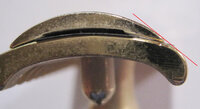
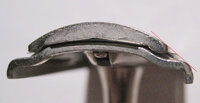
Few would use a Fatip OC at the neutral design angle. Virtually everyone would use a Tech at the neutral design angle.
Both are smooth and both are comfortable. The difference between them is the level of efficiency and the angle of use, blade edge to skin.
Using a Tech I shave at the neutral design angle with quite a lot of pressure to increase the efficiency as much as I can.
Using my Grande I, mostly, use a very shallow angle. Imagine the red line in the picture below as the level of my skin and note the angle of the blade edge to my skin.
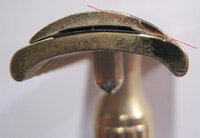
Used at that angle, I use more pressure with my Grande than I do my Tech just to allow me to reach that angle of blade to skin. The pressure applied however, is not edge to skin, its cap to skin. All pressure applied is at and between the green lines below.
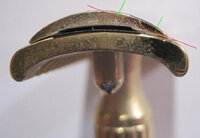
If I release pressure, even slightly, the blade lifts away from my skin.
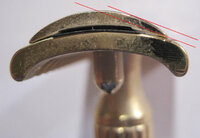
Using a Tech, theres no need to do any of that. With a solid technique however, my Grande is five times as efficient as my Tech while being just as smooth and comfortable, if not even more so because the Grande has less blade gap.
The differences between them being blade exposure, blade gap, technique and length of a BBS finish. My Grande consistently gives me a 12 hour BBS with a post shave feel like I havent even shaved. My Tech, a 6 hour BBS. If I increase pressure enough, I can stretch that to 8 hours but because of the blade gap, as minor as it is in a Tech, my skin pays a price.
Vlad hit that point below.
Another thing that stood out to me, in regards to blade exposure, I just learned on my last shave. I used my made in England Old Type clone and a Polsilver on its 5th shave.

I've used a Polsilver to 20 shaves in my Grande, easily. I never felt any tugging at all through those 20 shaves and all shaves were done at ~48 hours growth directly ATG buffing first pass.
However, on my last shave with my Brit clone, first pass N>S at ~78 hours growth the tugging was painful. To the point I reached for my Grande after my second stroke. I finished the shave with my clone though just so I could understand how the blade and razor performed through 3 passes and a clean up.
In that razor, that Polsilver blade was done at shave #4. Yet I know, if I put it in my Grande, it will perform as well as Polsilvers ever have for many more shaves.
The difference between that razor and a post war Tech is blade support and blade gap. Blade exposure is virtually identical but if you look at the picture closely, you'll see how the very edge of the cap is what clamps the blade to the base and beyond that clamping point the blade is unsupported and allows the blade to flex and even undulate as it encounters resistance. Hence the tugging.
If that razor had as much blade exposure as my Grande it would be unusable. If it had less blade exposure, even only slightly, the tugging I felt during that last shave would be lessened because the blade wouldnt flex as much.
Blade exposure is only one component of a razors design. Yes, it matters and yes it makes a difference, but so do all of the other design elements. They all work together. Change one design element and you change the characteristics of them all.
Increasing blade exposure increases efficiency. Angle of use, blade edge to skin, becomes more important as blade exposure increases.
Decreasing blade exposure lessens efficiency and angle of use becomes less critical.
Blade exposures of my Fatip Grande compared to a D2 Tech. The red line being the neutral design angle.


Few would use a Fatip OC at the neutral design angle. Virtually everyone would use a Tech at the neutral design angle.
Both are smooth and both are comfortable. The difference between them is the level of efficiency and the angle of use, blade edge to skin.
Using a Tech I shave at the neutral design angle with quite a lot of pressure to increase the efficiency as much as I can.
Using my Grande I, mostly, use a very shallow angle. Imagine the red line in the picture below as the level of my skin and note the angle of the blade edge to my skin.

Used at that angle, I use more pressure with my Grande than I do my Tech just to allow me to reach that angle of blade to skin. The pressure applied however, is not edge to skin, its cap to skin. All pressure applied is at and between the green lines below.

If I release pressure, even slightly, the blade lifts away from my skin.

Using a Tech, theres no need to do any of that. With a solid technique however, my Grande is five times as efficient as my Tech while being just as smooth and comfortable, if not even more so because the Grande has less blade gap.
The differences between them being blade exposure, blade gap, technique and length of a BBS finish. My Grande consistently gives me a 12 hour BBS with a post shave feel like I havent even shaved. My Tech, a 6 hour BBS. If I increase pressure enough, I can stretch that to 8 hours but because of the blade gap, as minor as it is in a Tech, my skin pays a price.
Vlad hit that point below.
This is where blade gap comes into play. Negative exposure and huge gap means you can really tuck a lot of skin under the blade. At this point one has to wonder if this is the proper way to shave, instead of getting razor with more blade exposure.
Another thing that stood out to me, in regards to blade exposure, I just learned on my last shave. I used my made in England Old Type clone and a Polsilver on its 5th shave.

I've used a Polsilver to 20 shaves in my Grande, easily. I never felt any tugging at all through those 20 shaves and all shaves were done at ~48 hours growth directly ATG buffing first pass.
However, on my last shave with my Brit clone, first pass N>S at ~78 hours growth the tugging was painful. To the point I reached for my Grande after my second stroke. I finished the shave with my clone though just so I could understand how the blade and razor performed through 3 passes and a clean up.
In that razor, that Polsilver blade was done at shave #4. Yet I know, if I put it in my Grande, it will perform as well as Polsilvers ever have for many more shaves.
The difference between that razor and a post war Tech is blade support and blade gap. Blade exposure is virtually identical but if you look at the picture closely, you'll see how the very edge of the cap is what clamps the blade to the base and beyond that clamping point the blade is unsupported and allows the blade to flex and even undulate as it encounters resistance. Hence the tugging.
If that razor had as much blade exposure as my Grande it would be unusable. If it had less blade exposure, even only slightly, the tugging I felt during that last shave would be lessened because the blade wouldnt flex as much.
Blade exposure is only one component of a razors design. Yes, it matters and yes it makes a difference, but so do all of the other design elements. They all work together. Change one design element and you change the characteristics of them all.
I agree with this.My understanding is that the more blade exposure you have, the greater the range of angle for an efficient shave. So less exposure would place a higher premium on perfect technique to get a close shave.
If I've got that right, then the better your angle control, the less exposure matters. Without drawing blood, you can't shave any closer than the surface of your skin, regardless of exposure, but greater exposure makes it easier to get down to that surface.
Just my $0.02. If there's an error in my logic somewhere, please enlighten me.
You can shave below the surface of the skin. How else would one achieve a BBS finish?
My Tech, 6 hour BBS.
My Grande, 12 hour BBS.
My MMOC, up to a 19 hour BBS with a fresh blade and a 14 hour BBS by shave 10 on a worn blade.
Blade exposure is the main component to those differences.
I define a BBS shave as not being able to feel any stubble, in any direction even with considerable pressure applied by my hand. I've also done it with a cotton ball, but feel is a better indicator.
How you achieve that is more complex. The right soap and prep is what makes the difference. The more supple the skin, the more forgiving it is for the blade.
My Tech, 6 hour BBS.
My Grande, 12 hour BBS.
My MMOC, up to a 19 hour BBS with a fresh blade and a 14 hour BBS by shave 10 on a worn blade.
Blade exposure is the main component to those differences.
I define a BBS shave as not being able to feel any stubble, in any direction even with considerable pressure applied by my hand. I've also done it with a cotton ball, but feel is a better indicator.
How you achieve that is more complex. The right soap and prep is what makes the difference. The more supple the skin, the more forgiving it is for the blade.
Cap span is simply how much blade sticks out from the cap.
Are you sure that’s what “cap span” means?. I thought that was “blade reveal”, here termed “free end distance”.
I think cap span and guard span just divide up the shaving plane, allowing for the terms “riding the guard” or “riding the cap”, particularly when it comes to positive blade exposure, as a triangle of sorts is formed between guard/razor blade edge/cap. To be clear, I truly don’t know and am asking.
The diagram above is consistent with my understanding of cap span and free end distance. You're right "Sticks out" I guess isn't a clear way of defining it which is why I posted the diagram in lieu of explaining what shave plane means. Typically folks like the OP are looking at how much blade is showing from above which is more about cap span than free end distance but it's not a distinction worth debating here.Are you sure that’s what “cap span” means?. I thought that was “blade reveal”, here termed “free end distance”.
I think cap span and guard span just divide up the shaving plane, allowing for the terms “riding the guard” or “riding the cap”, particularly when it comes to positive blade exposure, as a triangle of sorts is formed between guard/razor blade edge/cap. To be clear, I truly don’t know and am asking.
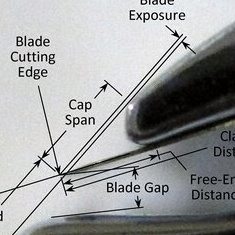
Last edited:
Got it! Thanks for clarifying.The diagram above is consistent with my understanding of cap span and free end distance. You're right "Sticks out" I guess isn't a clear way of defining it which is why I posted the diagram in lieu of explaining what shave plane means. Typically folks like the OP are looking at how much blade is showing from above which is more about cap span than free end distance but it's not a distinction worth debating here.

Similar threads
- Replies
- 8
- Views
- 608
- Replies
- 20
- Views
- 1K
- Replies
- 16
- Views
- 653




